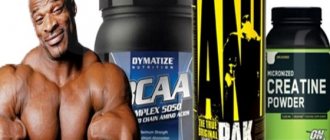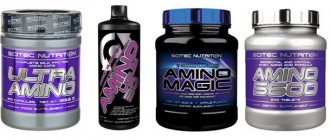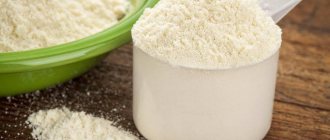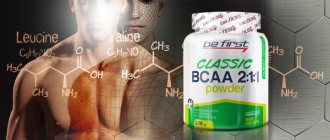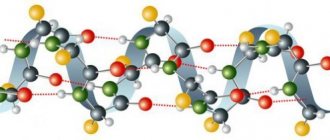Most people associate the word amino acids with a type of sports nutrition. Indeed, one of the main products in this segment is amino acid complexes and, in particular, BCAA amino acids. A natural question arises: what are amino acids needed for, who can get them and where can they be obtained from? To understand this, you must first decide what these substances initially are.
What are amino acids?
Amino acids are organic compounds that are a structural component of protein. Those. when we talk about the fact that protein is the main building material of the body’s tissues, that it is necessary for the growth of muscle mass and is indispensable for fat burning - all this, in fact, is about the amino acids that make up protein. Exaggeratedly, we can say that amino acids are proteins.
In nature, there are a huge number of varieties of amino acids and, accordingly, their classifications. However, all this is from the field of chemistry. Typically, there are 20 “essential” amino acids . They are what is meant when discussing the topic of nutrition, fitness, etc.
Why they were chosen as the “most important” amino acids is not entirely clear. However, it is important for us that these twenty amino acids are divided into two classes depending on whether the body can synthesize (produce) them independently: replaceable and essential.
Amino acid complexes
When you take single amino acid supplements, it is also recommended to include amino acid complexes in your sports nutrition to ensure that you are getting all the nutrients you need to properly build muscle mass.
By consuming a full spectrum of amino acids, living a healthy lifestyle, and training hard in the gym, you are giving your muscles everything they need to build the body of their dreams!
Some companies offer amino acid complexes in tablets, capsules and liquid form.
Good examples are Amino 2222 Optimum Nutrition and Twinlab Amino Fuel. Try using an amino acid supplement such as Amino 2222 half an hour before meals, followed by a glutamine supplement 30 minutes before and 30 minutes after your workouts.
The following products are popular in the CIS.
Types of amino acids: essential and essential
Nonessential amino acids are those that the body can obtain in two ways: either ready-made from food, or produced independently from other types of amino acids and substances entering the body.
Essential amino acids include: arginine, asparagine, glutamine, glutamic acid, glycine, carnitine, ornithine, taurine (sometimes proline and serine are included in this list).
Essential amino acids - these amino acids the body is not able to synthesize itself and can only be obtained from food. To be more precise, this class is divided into essential and conditionally essential amino acids - in fact, they are produced in the body, but in negligible quantities and therefore their additional intake is extremely necessary.
Essential amino acids include: valine, isoleucine, leucine, lysine, methionine, threonine, tryptophan, phenylalanine.
Conditionally essential amino acids include: tyrosine, cysteine, histidine, alanine.
The amino acids in these classifications may vary slightly from source to source. Sometimes this list is supplemented with several other elements. Sometimes the “degree of importance” is questioned by some, but, nevertheless, this list can be called basic.
Branched Chain Amino Acids (BCAAs)
Leucine, isoleucine and valine
Of the 9 essential amino acids, 3 are classified as branched chain amino acids. These are leucine, isoleucine and valine. BCAAs have a unique chemical structure compared to other essential amino acids, and therefore have special properties. Unlike other amino acids, BCAAs are absorbed faster and better by the body, that is, they are not absorbed in the stomach, but actually go directly to the muscles. To learn more about BCAA, read our article “BCAA. What are branched chain amino acids?
Sources of amino acids
Naturally, the main source of amino acids is food rich in protein. However, based on the content of certain amino acids, proteins contained in food can be divided into complete and incomplete.
Complete proteins contain all the essential amino acids. These products include mainly products of animal origin: meat, poultry, fish, eggs, dairy products. Soy is a plant source of complete protein.
Among all products, the chicken egg is considered the highest quality source of complete proteins, since it not only contains a complete set of essential amino acids, but also their best ratio.
Incomplete proteins - they lack at least one essential acid. Accordingly, defective proteins can vary greatly in their “quality”. After all, the same group of “inferior” proteins will include those proteins that have only one essential amino acid and those that have seven of them. The source of incomplete proteins are mainly products of plant origin: legumes, cereals, nuts and seeds.
I would like to draw attention to one nuance that usually becomes a stumbling block in disputes between vegetarians and those who eat meat and animal products: protein is found in almost all products . And if you take into account even its microdoses, then, most likely, in everyone. The question is different: the quality of the protein (complete or incomplete) and its quantity. There is protein in both broccoli and chicken breast. It’s just that cabbage contains 3 g per 100 g of product, and chicken meat contains 23 g.
To make this information more clear, I will give an example. Let's say there is a person who plays sports and weighs 70 kg. He needs, say, 1.2 g of protein per kg of body weight, respectively, at least 84 g. He can get it from 360 g of chicken, or from 2.8 kg of broccoli. And this is only a quantitative indicator. The quality of animal protein will be higher.
How to take amino acids correctly
By providing your body with enough amino acids to create proteins to build muscle and sculpt your incredible body, you are making the right investment.
Dosage and advice for taking
Amino acids are available in the form of powder, tablets, capsules and solutions. There are amino acids in the form of injections, injected into a vein. The release form does not at all affect the degree of effectiveness of the additive; they are all equivalent in their effect.
The dosage of amino acids in bodybuilding should be prescribed individually, taking into account the characteristics of a particular organism. A single dose should be at least 5 g, but the maximum result is achieved with a single dose of 10-20 g.
If your goal is to gain muscle mass, then it is better to take amino acids before and after training, and also once in the morning. If you want to lose weight, then the intervals between doses can be shortened: take it in the morning, before and after fat-burning workouts.
Reception features
Amino acids go well with different types of sports nutrition, but you can’t always take them at the same time and mix them.
It is not recommended to take amino acid complexes with protein, gainer, meal replacement or food, otherwise their absorption will take a very long time, which means the intake will become ineffective. Always read the manufacturer's instructions.
A logical question arises: is everything really so smooth and don’t such super-healthy supplements have side effects? Surprisingly, they really don’t exist, because amino acids are natural components of food, and the duration of their intake is not limited in any way - you can drink them without even taking breaks, unlike, for example, L-carnitine.
Functions of amino acids in the body
In a broad sense, the amino acids that make up protein are the building blocks of all body structures. Each amino acid individually performs its irreplaceable role. However, to summarize, the following main functions of amino acids can be distinguished:
- protein synthesis
- maintaining the activity of mental processes (amino acids function as neurotransmitters, being conductors of nerve impulses)
- regulation of the CNS (central nervous system)
- muscle fiber formation
- restoration of tissues and organs after injury
- being the main component of enzymes, they regulate metabolic processes in the body (including carbohydrate and lipid metabolism)
- regulate hormonal levels
And these are just the main ones. I will not exaggerate if I say that amino acids are involved in absolutely all processes occurring in the body.
What is glutamine for?
Glutamine is an amino acid that limits the synthesis of protein, which makes up our immune tissue - lymph nodes and individual formations of lymphoid tissue. The importance of this system is difficult to overestimate: without proper resistance to infections, there is no need to talk about any training process. Moreover, every workout - no matter professional or amateur - is dosed stress for the body.
Stress is a necessary condition to move our “equilibrium point”, that is, to cause certain biochemical and physiological changes in the body. Any stress is a chain of reactions that mobilize the body. During the interval that characterizes the regression of the cascade of reactions of the sympathoadrenal system (namely, they represent stress), a decrease in the synthesis of lymphoid tissue occurs. For this reason, the decay process exceeds the rate of synthesis, which means the immune system weakens. So, additional intake of glutamine minimizes this extremely undesirable, but inevitable effect of physical activity
Optimal amino acid ratio
I have never been able to find a more or less reliable source of information about what the ratio of proteins in the human diet should be. A range of animal to plant protein ratios is mentioned from 65:35 to 45:55. I think it’s worth following the golden mean and sticking to the 50:50 ratio.
But it is also important to understand that such a calculation will not necessarily give you the full spectrum of essential amino acids. After all, even if we are talking about a complete protein containing all the essential amino acids, the quantity and proportions of these amino acids in a given product also play a role. They may all be there, but simply in small quantities or there may be a deficiency of a specific amino acid.
Of course, few of us will sit and meticulously calculate the amount of all the amino acids and their proportions in our diet. This is why adequate protein intake and a 50:50 ratio of animal to plant proteins should presumably cover your amino acid requirements. By the way, the combination of buckwheat with meat gives approximately the same ratio. And do not forget that animal protein is absorbed by the body much better than plant protein.
The situation is much more complicated for vegetarians . They need to very seriously think through their diet in order to more or less compensate for the lack of essential amino acids from plant sources.
Test on the topic
- /5
Question 1 of 5What properties do amino acids exhibit?
Start test
Hall of Fame
To get here, take the test.
- Guzel Fatkullina
4/5
- Anna Tunik
5/5
- Irina Kuzmenko
5/5
- Gosha Khachev
4/5
- Nikita Baymetov
5/5
Plant and animal protein: which is better?
This is the formulation of the question that very often appears when discussing animal and vegetable protein, and it is fundamentally incorrect. There is no “bad” or “good” protein, they are different and the body needs both the first and the second in sufficient quantities. As mentioned above, all proteins have different amino acid composition. And we need ALL amino acids . Each of them performs its own function and, accordingly, the lack of any of them will sooner or later negatively affect the functioning of the body.
Some would say that complete proteins are more important because they contain essential amino acids. But if you eat only animal protein, a person will still experience a lack of those acids that they do not contain. In addition, the benefits of products are determined not only by the presence of amino acids. The ratio of proteins, “good” and “bad” fats and carbohydrates also plays a huge role. After all, if a product is rich in essential amino acids, but at the same time contains a lot of animal fats, its “usefulness” will significantly decrease even for those who do not watch their figure. Therefore, there is only one conclusion - the diet should be as varied as possible in order to fully cover the need for amino acids.
The amount of amino acids needed by a person involved in sports increases sharply. Accordingly, you need to either strictly control their intake from food, or take additional portions of amino acids in the form of sports nutrition supplements (for example, BCAAs).
But this does not mean that supplements are mandatory. It is quite possible to structure your diet in such a way as to cover all your amino acid needs. Sports nutrition has its benefits, but unless you are a competitive athlete, taking it is not absolutely necessary.
In the tables below you can find information about the main amino acids, their functions and sources. Among the products, only those in which each of the amino acids is found in more or less significant quantities are indicated.
Essential amino acids
| Amino acid | Functions | Sources |
| Valin |
|
|
| Isoleucine |
|
|
| Leucine |
|
|
| Lysine |
|
|
| Methionine |
|
|
| Threonine |
|
|
| Tryptophan |
|
|
| Phenylalanine |
|
|
Conditionally essential amino acids
| Amino acid | Functions | Sources |
| Tyrosine |
|
|
| Cysteine |
|
|
| Histidine |
|
|
Daily requirement
The body needs absolutely all amino acids. Their number should be harmonious. The ratio of animal proteins to plant proteins is 65:36-45:55. It is important not only the presence of organic compounds in the product, but also their concentration.
The quality of the protein is essential. Animal products are digested better than plant products. To cover the need for amino acids, you need to include food from different groups in your diet.
Attention! The daily requirement depends on the type of substance. The total amount is up to 2 g.
What factors influence the content of amino acids in the body?
Some people have impaired absorption of organic compounds, which can cause allergic reactions. This phenomenon is usually congenital in nature and requires a decrease in the amount of nutrients supplied.
Increasing the concentration of nutrients is required in the following cases:
- active growth;
- professional sports;
- intense mental and physical stress;
- period after a long illness.
The digestibility of proteins depends on the type of product. The maximum indicator is observed for the following items:
- egg white;
- lean meats and fish;
- cottage cheese.
It is also important to combine products correctly. For example, you can add milk to buckwheat porridge. Cottage cheese and meat are suitable for flour products.
Attention! Organic compounds dissolve in water and interact with certain vitamins and minerals. They are involved in the synthesis of important hormones: adrenaline, melanin, serotonin, norepinephrine, serotonin.
Causes and signs of deficiency and excess
Amino acids are found in foods. Some substances can be synthesized in the body. The lack and increase in the concentration of certain proteins is caused by an inadequate diet and abuse of certain foods. Sometimes an imbalance occurs due to liver pathologies and diabetes.
Symptoms of organic compound deficiency include:
- decreased appetite;
- drowsiness and weakness;
- hair loss;
- delayed development and growth;
- deterioration of the skin condition;
- anemia;
- frequent ARVI.
Against the background of excess proteins, the following symptoms may be observed:
- hypertension;
- dysfunction of the thyroid gland;
- early gray hair;
- joint pathologies;
- risk of increased stroke and heart attack.
Important! An increase in the level of amino acids occurs with a deficiency of selenium, ascorbic acid, tocopherol, retinol and B vitamins. It is these nutrients that neutralize excess proteins.


